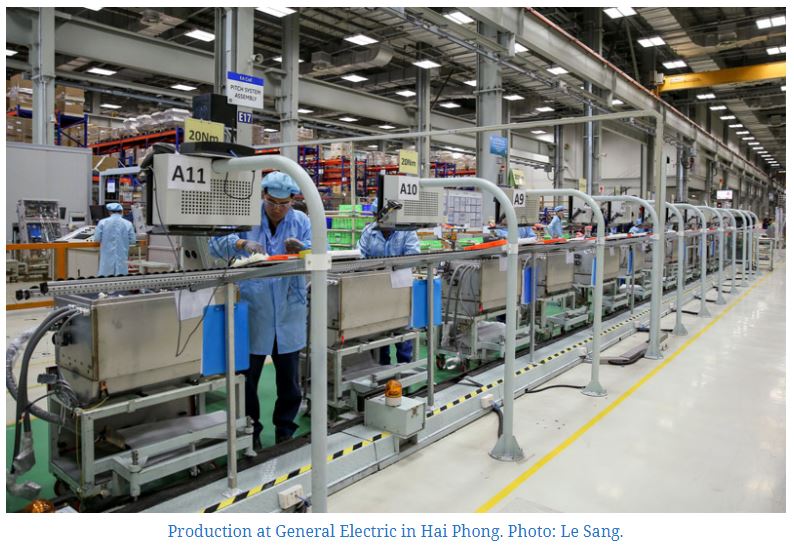Vietnam emerges as top destination for global investors in 2020
The Hanoitimes – Given uncertainties surrounding the US – China relations and the serious Covid-19 situations globally, Vietnam has become a logical choice in the eyes of investors.
In 2020, Vietnam has emerged as a favorite destination for a shift in global investment capital, so the question now is whether the country can fully grasp this opportunity to aid its growth efforts.
In late November, a report from Reuters suggested Apple has requested Foxconn to move part of its Ipad and MacBook production chain from China to Vietnam. Foxconn’s manufacturing plant is currently under construction in the northern province of Bac Giang and on track for operation in the first half of 2021.
Vietnam’s Ministry of Planning and Investment in September revealed Taiwan-based Pegatron, manufacturing partner of the world’s major tech firms such as Microsoft, Apple or Sony, has also planned to invest US$1 billion to build a manufacturing complex at Nam Dinh Vu industrial park in the northern city of Hai Phong.
Such movements from multinationals are part of a global investment trend to Vietnam throughout the year. In July, the Japan External Trade Organization (JETRO) has released a list of 30 Japanese firms that are poised to receive subsidies from its government to move production facilities from China to Southeast Asian countries, with half of the list eyeing Vietnam as a possible destination.
A semi-annual industrial production report released by the Ministry of Industry and Trade (MoIT) in the first half of this year mentioned major tech firms, including LG and Panasonic, are looking to shift or expand production in Vietnam.
In fact, Panasonic in May announced its intention to move its Thai-based production of refrigerators and washing machines to Vietnam. Nikkei also reported Google and Microsoft are expanding operations in Vietnam to take advantage of the country’s constantly improved business/investment environment.
While the US-China trade war has long been mentioned as a key factor leading to a shift of investment capital out of China, the emergence of the Covid-19 pandemic has exposed shortcomings of the current global supply chains, which are heavily dependent on certain production hubs, including China.
Under this context, US President Donald Trump has called for companies to bring production back to their home country, while the Japanese government has been providing financial support for enterprises to diversify supply chains, instead of staying in China.
President of the Japan International Cooperation Agency (JICA) Kitaoka Shinichi in a meeting with Prime Minister Nguyen Xuan Phuc on December 11 said Japan is rebuilding new supply chains and Vietnam remains an ideal option during this process.
Even when there will soon be a new US administration, the current US-China relations could not reverse just as shortly, as Reuters in October reported that US-President elect Joe Biden said he would consult with US main allies before deciding on the future of US tariffs on China.
Given uncertainties surrounding the US – China relations and the serious Covid-19 situations globally, Vietnam has become a logical choice in the eyes of investors. “With its solid macroeconomic background and the ability to handle and repel the pandemic, it is not difficult to see that Vietnam will continue to be a bright investment destination in the region, especially in the electronic component manufacturing industry,” Tim Evans, CEO of HSBC Vietnam wrote in a note.
According to the HSBC CEO, another bright spot for Vietnam’s economy in 2020 has been the government’s consensus in pursuing the international trade integration policy, which has been reflected by the conclusion of negotiation of the UK Vietnam Free Trade Agreement (UKVFTA) in December, the effect in August of the Vietnam – EU Free Trade Agreement (EVFTA) and the recently signed Regional Comprehensive Economic Partnership (RCEP).
Mr. Evans expected Vietnam’s economic openness and efforts towards global integration help local firms to access foreign investment capital and enhance their competitiveness.
Long-term plan required
Statistics from the MPI informed FDI commitments in the January – November period fell nearly 17% year-on-year to US$26.4 billion. Up to November 20, a number of 2,313 new projects has been approved with total registered capital of US$13.6 billion, down 33.5% in the number of projects and 7.6% in capital year-on-year. Investors have poured money into 18 fields and sectors, in which manufacturing and processing led the pack with investment capital of over US$12.7 billion, accounting for 48.1% of total registered capital.
Deputy Regional Managing Director and Representative of the US – ASEAN Business Council in Vietnam Vu Tu Thanh in a conference in mid-October said no multinationals or US firms want to leave China, as the option to go beyond China is only to help them evade the US tariffs or pursue the China plus 1 strategy.
A recent article from the Wall Street Journal said while Vietnam continues to be an attractive option with cheap labor cost, a population of 100 million remains small compared to China with 1.3 billion people.
To further solidify Vietnam’s position as an attractive investment destination in long-term, McKinsey Vietnam expected the government to continue investing in education and infrastructure.
A high-quality workforce could be a plus point for producers in the era of Industry 4.0, at the same time helping Vietnam further integrate into global value chains.
Mc Kinsey also noted Vietnam should focus on improving its existing infrastructure, especially in airports and ports, that are being overloaded in Hanoi or Ho Chi Minh City.
Source: http://hanoitimes.vn/vietnam-emerges-as-top-destination-for-shift-in-global-investment-capital-in-2020-315465.html


 Thailand
Thailand




